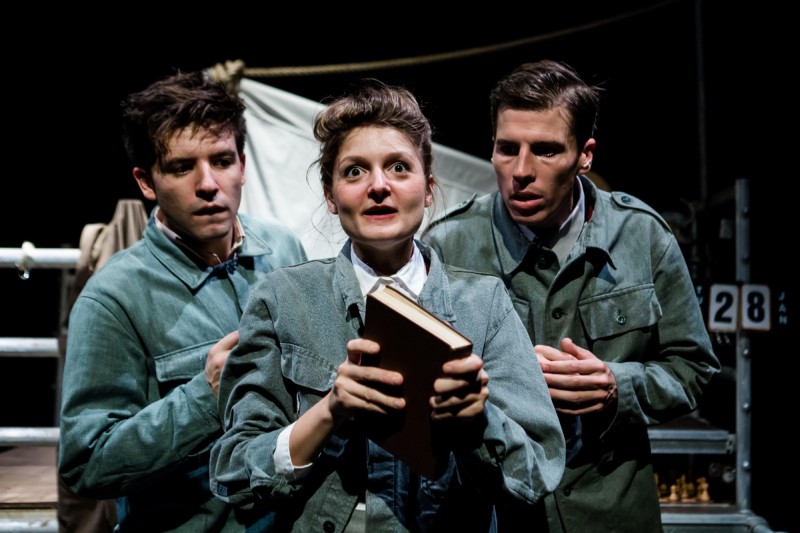 There is a drummer at his drum kit, dim light, smoke, and three performers dressed in grubby wartime hotel worker uniforms. There’s a large square of canvas on a rolling scaffold at the back and an air of suspense, intent, and unease.
There is a drummer at his drum kit, dim light, smoke, and three performers dressed in grubby wartime hotel worker uniforms. There’s a large square of canvas on a rolling scaffold at the back and an air of suspense, intent, and unease.
Stefan Zweig’s novel The Royal Game tells a tale of love, loss, solitary confinement, interrogation, and chess, ultimately leading to madness and the multiplication or splintering of its protagonist’s mind and person: the unease seems fitting. This adaptation sees the cast paint deft pictures of 1930s Europe with slick and masterful play of multi-roling, a sultry, live jazz percussion score, and many striking images and smart physical signatures that represent the fractured memory of a man driven mad.
We are whisked along with great energy and pace as our performers, all playing the divided protagonist, pull at submerged memories to try and string together a coherent story of how he has arrived here. In magical moments of object manipulation, boats are made out of chess boards tumbling through storms while the live score from the drummer summons the effect of sea sickness. We are shown the underbelly of a ship, with clever use of hand held torches and shadow to create the suffocating effect of dark tunnels and a heaving engine. We travel to hotel dances in Vienna, 1937, all crystal tumblers and smooth music, see our protagonist’s world begin to crumble into a snowstorm of weathered paper files in the moment his love is taken by the Gestapo. As disasters begin to engulf him, his memories begin to slip and repeat effectively as less and less defined images.
There is no doubt that this company has physical theatre skills in abundance: they shift perspective in a snap and their hands draw out scenography and objects with ease and precision. They have complicite and charm and this is a solid and intent telling of an engaging story. Yet perhaps in their attention to skill and detail they miss some of its heart and grit. Trained at L’ecole Lecoq, there is a signature style of emphatic and precise physicality with sparing and intelligent use of stagecraft that feels familiar to an audience now au fait with this physical theatre form. Perhaps I was looking for a development on this, a unique twist or something that made the story relevant to us today. The slick skill serves to impress but narrowly misses truly serving the story. A little more stillness and space for the deep human emotion that is present in the theme would open up a place where I could feel more moved. Nevertheless this is an impressive piece of theatre with excellent design, strong performance and evidence of a company who really know how to work well in an ensemble.
